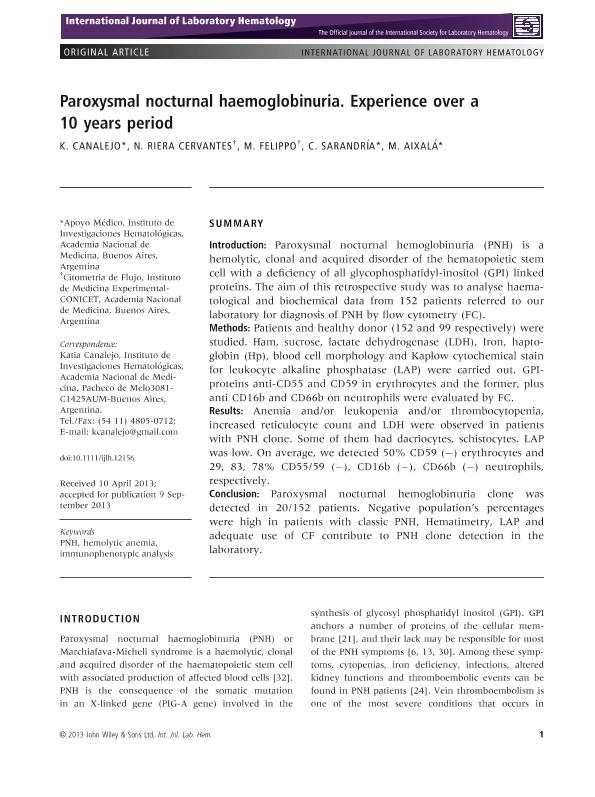Artículo
Paroxymal nocturnal haemoglobinuria: experience over 10 years period
Fecha de publicación:
04/2014
Editorial:
Wiley
Revista:
International Journal of Laboratory Hematology
ISSN:
1751-5521
e-ISSN:
1751-553X
Idioma:
Inglés
Tipo de recurso:
Artículo publicado
Clasificación temática:
Resumen
Introduction: Paroxysmal nocturnal hemoglobinuria (PNH) is a hemolytic, clonal and acquired disorder of the hematopoietic stem cell with a deficiency of all glycophosphatidyl-inositol (GPI) linked proteins. The aim of this retrospective study was to analyse haematological and biochemical data from 152 patients referred to our laboratory for diagnosis of PNH by flow cytometry (FC). Methods: Patients and healthy donor (152 and 99 respectively) were studied. Ham, sucrose, lactate dehydrogenase (LDH), Iron, haptoglobin (Hp), blood cell morphology and Kaplow cytochemical stain for leukocyte alkaline phosphatase (LAP) were carried out. GPI-proteins anti-CD55 and CD59 in erythrocytes and the former, plus anti CD16b and CD66b on neutrophils were evaluated by FC. Results: Anemia and/or leukopenia and/or thrombocytopenia, increased reticulocyte count and LDH were observed in patients with PNH clone. Some of them had dacriocytes, schistocytes. LAP was low. On average, we detected 50% CD59 (−) erythrocytes and 29, 83, 78% CD55/59 (−), CD16b (−), CD66b (−) neutrophils, respectively. Conclusion: Paroxysmal nocturnal hemoglobinuria clone was detected in 20/152 patients. Negative population's percentages were high in patients with classic PNH, Hematimetry, LAP and adequate use of CF contribute to PNH clone detection in the laboratory.
Palabras clave:
Neutropenia
,
Anti-Pmn Antibodies
,
Flow Cytometry
,
Gift- Cd16blow
Archivos asociados
Licencia
Identificadores
Colecciones
Articulos(IMEX)
Articulos de INST.DE MEDICINA EXPERIMENTAL
Articulos de INST.DE MEDICINA EXPERIMENTAL
Citación
Canalejo, K.; Riera Cervantes, Norma Edith; Felippo, Marta Elena; Sarandría, C.; Aixalá, M.; Paroxymal nocturnal haemoglobinuria: experience over 10 years period; Wiley; International Journal of Laboratory Hematology; 36; 2; 4-2014; 213-221
Compartir
Altmétricas




